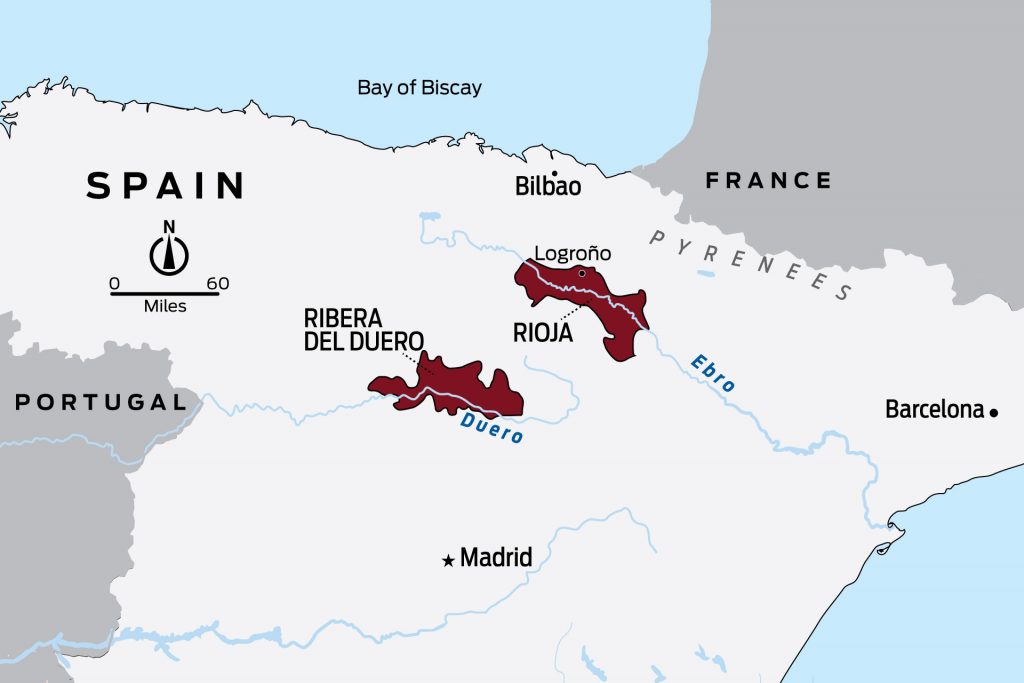Culture
The Differences Between Rioja and Ribera del Duero
By Mike Desimone

Rioja Vineyard provided by Getty

Map provided designmaps.com
In Spain, if you want vino tinto, or red wine, you usually order by region, asking the waiter to bring a glass of Rioja or Ribera del Duero. Both regions produce age-worthy, Tempranillo-based red wines with bold fruit flavors and notes of toast and spice.
Aging regulations for Rioja and Ribera del Duero are identical, too. Crianza wines require a minimum of two years’ aging, one in barrel and one in bottle. Reserva wines have a minimum of three years of aging, with at least one year in barrel and the remainder in bottle. Gran Reserva wines are aged in barrel for two years, followed by three years in bottle prior to release. The term Cosecha describes wines that are aged less than Crianza, or to those that have received lengthy time in barrel or bottle without conforming to the above categories exactly.
Despite these similarities, many people in Spain have very strong opinions on Rioja and Ribera del Duero wines and choose sides as if they were opposing teams in an end-of-season playoff game.
Rioja vs Ribera del Duero
The two regions are in northern Spain and are north of the capital, Madrid, which has been compared to the center point of the face on a clock. With that analogy in mind, Ribera del Duero is directly above Madrid, heading towards 12:00, while Rioja is to the northeast, between 1:00 and 2:00. The two regions are about three hours apart from one another by car and neither is coastal, though Rioja is closer to the North Atlantic, known locally as the Cantabrian Sea. Rioja became Spain’s first Denominacion de Origen (DO) in 1925. It was also the country’s first Denominacion de Origen Calificada (DOCa), a distinction earned in 1991.
A relatively large region, Rioja spans three provinces in the Ebro River Valley and has three subregions, Rioja Alavesa, Rioja Alta and Rioja Oriental. The region is home to more than 600 wineries where growers cultivate Tempranillo and other varieties on 160,000 acres of vineyards. Rioja has Atlantic, Mediterranean and continental climate influences.
Wine has been made in Rioja since Roman times, and it is believed that barrel aging was introduced in the 1780s. In the 1850s, as phylloxera ravaged the vineyards of France, winemakers from Bordeaux moved to Rioja and began plying their trade, ushering in the region’s modern era of winemaking. New rules were passed in 2018 allowing for wines with village and single-vineyard appellations.
Running about 70 miles east to west along the banks of the Duero River, Ribera del Duero is home to 61,000 acres of vineyards and more than 300 wineries. The region sits on a mesa, or high mountain plain, with altitudes between 2,300 and almost 3,600 feet above sea level. Strong day-to-night temperature shifts help preserve the grapes’ acidity, adding to its freshness and ageability.
Winemaking in Ribera del Duero dates to the Roman era as well. Benedictine monks from Burgundy were active in viticulture and winemaking in the 12th century. Although iconic winery Vega Sicilia began making wine in the 1850s, there were only nine wineries in Ribera del Duero when it received DO status in 1982.
